Text

Vasily Tropinin. Self-Portrait with Brushes and a Palette Against a Window Facing the Kremlin.
1846. State Tretyakov Gallery, Moscow.
The outstanding Russian painter Vasily Andreevich Tropinin was born a serf peasant and until 1823 he was a serf of Count A.S. Minikh, and later Count I.I. Morkov. He got his freedom only at the age of 47, when he already became a famous artist. Having gained the long-awaited freedom, Tropinin decided to settle in Moscow, where he became one of the most respected artists among the residents of the city. His paintings are painted in the spirit of realism with notes of romanticism.
#Vasily Tropinin#Self-Portrait with Brushes and a Palette Against a Window Facing the Kremlin#XIX century#art#Russia#Moscow#State Tretyakov Gallery#Romanticism#portrait#Василий Тропинин#XIX век#искусство#Автопортрет на фоне окна с видом на Кремль#Государственная Третьяковская галерея#портрет#романтизм#Москва#Россия#живопись
0 notes
Text

Vasili Pukirev. Unequal Marriage.
1862–1862. State Tretyakov Gallery, Moscow.
Unequal Marriage is a masterpiece of Vasily Pukirev (1832-1890). It is one of art history's most heartbreaking paintings. To study it, you need to keep track of the whole "abyss of little things", for every detail, because otherwise we risk missing a lot.
There are two strange figures on the canvas — old women. One stands behind the groom, the other behind the priest. Both for some reason came in wreaths, and one either in a white dress, or even in a sheet or a funeral shroud. The figure of the second bride behind the priest's back looks even more strange, because this is not according to the rules of the rite. There is nothing for guests to do next to the priest — unless, of course, they come from another world.
It turns out that there are three brides at the wedding at once. Two of them are dead and looking at the old groom. And here is the artist Vasily Pukirev! He's standing with his arms crossed in the right corner and looking at the young bride. Next to him, his friend, the artist Pyotr Shmelkov, who suggested the idea of the painting to him, looks at us and seems to be asking a question: "Do you understand what's going on?".
#Vasili Pukirev#Unequal Marriage#XIX century#State Tretyakov Gallery#Moscow#Russia#art#heartbreaking#tragic#marriage#Василий Пукирев#Неравный брак#XIX век#Государственная Третьяковская галерея#Москва#Россия#искусство
44 notes
·
View notes
Text
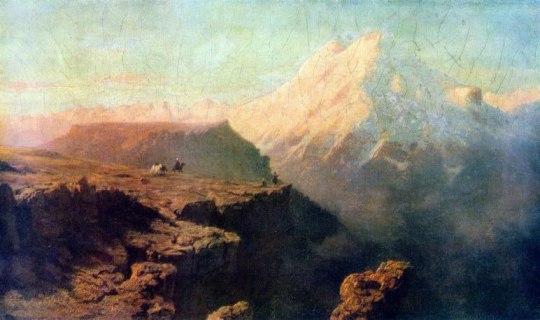
Mikhail Lermontov. Elbrus at sunrise.
1837-1838. The Lermontov National Memorial Estate Tarkhany, Penza Region.
Few people know, but the great Russian poet Mikhail Yuryevich Lermontov learned to draw before writing poetry. His artistic heritage is represented by many oil paintings, pencil drawings, miniatures and illustrations for literary works. At the same time, Lermontov worked in various techniques — in painting, watercolor, drawing and lithography. Mount Elbrus, which is the highest mountain peak in Russia and Europe, was painted in the rays of the rising sun by Lermontov after his return from his first exile to the Caucasus.
#Mikhail Lermontov#Elbrus at sunrise#XIX century#The Lermontov National Memorial Estate Tarkhany#Penza Region#art#Russia#landscape art#Михаил Лермонтов#Эльбрус на восходе солнца#XIX век#Государственный музей-заповедник «Тарханы»#Пенза#искусство#пейзаж#Эльбрус
14 notes
·
View notes
Photo

Karl Bryullov. Italian, Expecting a Child, Looking at His Shirt, Her Husband Cobble Together a Cradle.
1831. State Russian Museum, St. Petersburg.
#Karl Bryullov#Italian Expecting a Child Looking at His Shirt Her Husband Cobble Together a Cradle#XIX century#State Russian Museum#saint petersburg#Russia#art#Italian#Romanticism#Карл Брюллов#Итальянка ожидающая ребенка разглядывает рубашку муж сколачивает колыбель#XIX век#Государственный русский музей#Санкт-Петербург#Россия#искусство#Италия#романтизм
37 notes
·
View notes
Photo
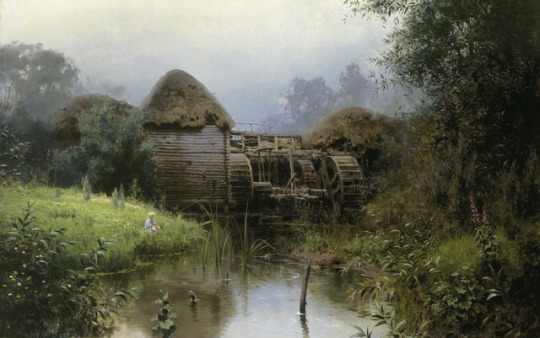
Vasily Polenov. Old mill.
1880. Serpukhov Art Museum of History, Moscow Region.
#Vasily Polenov#Old mill#XIX century#Serpukhov Art Museum of History#realism#Moscow Region#Russia#art#landscape art#melancholy#nature#mist#Василий Поленов#Старая мельница#XIX век#Серпуховский историко-художественный музей#Московская область#Россия#искусство#пейзаж#меланхолия#туман#природа#реализм
73 notes
·
View notes
Photo

Vyacheslav Fyodorov. Fog.
1970s. Museum of Russian Impressionism, Moscow.
Vyacheslav Fyodorov considered Konstantin Korovin, Vasily Polenov and Alexei Savrasov as his teachers, yet the real school which formed and shaped his talent was that of nature itself. Landscape became almost the only genre in which he worked, and whenever he went out into the open air, he could create dozens of versions of the same view. He did not change anything in the details of composition, instead his goal was to capture the fleeting nuances of the ever-changing scene. The great Claude Monet worked in the same way, time and again re-creating his Rouen Cathedral or Westminster Abbey. Fyodorov pursued the same objective when creating "Fog". Look closely at his colourful transitions to the heavy vibration of the moist air over the river, at the birch reflections in the water, and the depth of the compelling pattern of the blue morning mist in May.
#Vyacheslav Fyodorov#Fog#Museum of Russian Impressionism#impressionism#XX century#Moscow#Russia#art#nature#Вячеслав Федоров#Туман#Музей русского импрессионизма#импрессионизм#Москва#Россия#искусство#природа
10 notes
·
View notes
Photo
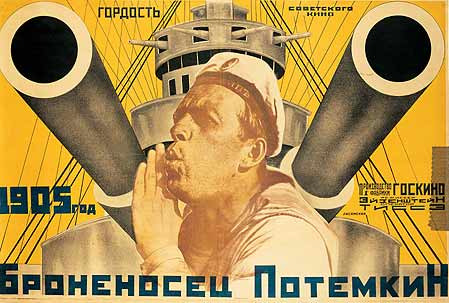
Anton Lavinsky. Poster for Sergei Eisenstein’s Battleship Potemkin.
1925. Chrome lithograph. Production of the 3rd Factory of Goskino. State Russian Museum, St. Petersburg.
Poster for the film 'The Battleship Potemkin', 1926, directed by Sergei Eisenstein. Sergei Eisenstein was a Soviet film director and film theorist, a pioneer in the theory and practice of montage. 'The Battleship Potemkin' presents a dramatized version of the mutiny that occurred in 1905 when the crew of the Russian battleship Potemkin rebelled against their officers.
The Russian battleship Potemkin was a pre-dreadnought battleship built for the Imperial Russian Navy's Black Sea Fleet. It became famous when the crew rebelled against the officers in June 1905 (during that year's revolution), which is now viewed as a first step towards the Russian Revolution of 1917.
#Anton Lavinsky#Poster for Sergei Eisenstein’s Battleship Potemkin#Chrome lithograph#poster#XX century#art#Soviet art#Soviet union#USSR#Sergei Eisenstein#Revolution#saint petersburg#Russia#State Russian Museum#Антон Лавинский#Броненосец «Потемкин»: 1905 год#XX век#плакат#постер#Хромолитография#Государственный русский музей#Санкт-Петербург#Россия#искусство#СССР#Сергей Эйзенштейн#революция#советское искусство
9 notes
·
View notes
Photo

Mikhail Lebedev. An Alley in Albano.
1836. State Tretyakov Gallery, Moscow.
#Mikhail Lebedev#An Alley in Albano#XIX century#State Tretyakov Gallery#Moscow#Russia#art#realism#landscape art#Михаил Лебедев#Аллея в Альбано#XIX век#Москва#Россия#Государственная Третьяковская галерея#искусство#реализм#пейзаж
19 notes
·
View notes
Photo

Ilya Repin. Alexander III receiving rural district elders in the yard of Petrovsky Palace in Moscow.
1885-1886. State Tretyakov Gallery, Moscow.
#Ilya Repin#Alexander III receiving rural district elders in the yard of Petrovsky Palace in Moscow#XIX century#State Tretyakov Gallery#Moscow#Russia#realism#historical art#historical painting#history#empire#Russian empire#Илья Репин#Прием волостных старшин императором Александром III во дворе Петровского дворца в Москве#XIX век#Государственная Третьяковская галерея#Москва#Россия#реализм#историческая живопись#история#российская империя#империя#monarchy#монархия
16 notes
·
View notes
Photo

Arkhip Kuindzhi. Ukrainian Night.
1876. State Tretyakov Gallery, Moscow.
#Arkhip Kuindzhi#Ukrainian Night#XIX century#art#realism#landscape art#nature#ukraine#Moscow#Russia#Архип Куинджи#Украинская ночь#night#ночь#реализм#искусство#XIX век#State Tretyakov Gallery#Москва#Россия#природа#Украина#пейзаж
20 notes
·
View notes
Photo
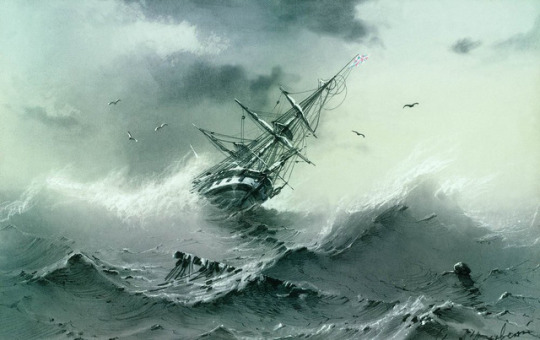
Ivan Aivazovsky. Shipwreck.
1854. State Russian Museum, Saint Petersburg.
This painting is a testament to the artist’s skill of portraying light and dark. With nothing more than a pencil and gouache on paper, this scene illustrates the strong winds and crash of the waves with violent intensity. This intensity makes you fear for the safety of the standing observers, as if the waves threaten to dash the ship against the cliff, upon which they are standing, and throw them into the sea. Three seagulls fly over the ship, creating the slight sense that all hope is not lost, and seeming as if is not impossible to hope that the ship may not yet be lost.
#Ivan Aivazovsky#Shipwreck#romanticism#art#marina#Russia#Saint Petersburg#nature#sea#storm#ship#Иван Айвазовский#Тонущий корабль#XIX century#XIX век#романтизм#Государственный русский музей#State Russian Museum#Санкт-Петербург#Россия#искусство#природа#море#корабль#шторм#стихия
16 notes
·
View notes
Photo

Edward Putintsev. Karelia. Stones. By the evening.
1989.
#Edward Putintsev#Karelia#Stones#By the evening#XX century#Russia#art#landscape art#Northern nature#north#sunset#melancholy#water#river#Эдуард Путинцев#Карелия#Камни#К вечеру#XX век#Россия#искусство#река#север#природа#пейзаж
21 notes
·
View notes
Photo
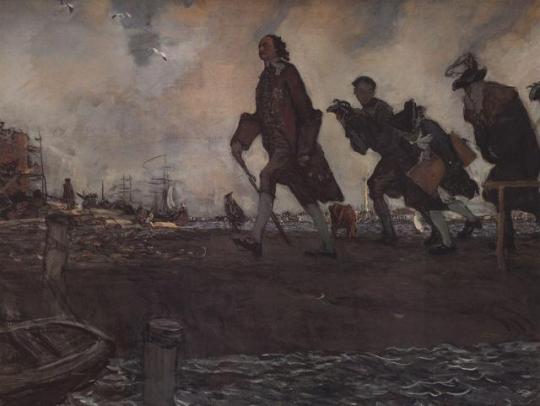
Valentin Serov. Peter I The Great.
1907. State Tretyakov Gallery, Moscow.
Peter I, or Peter the Great (1672-1725), was one of the most outstanding rulers and reformers in Russian history. He was at first a joint ruler with his weak and sickly half-brother, Ivan V, and his sister, Sophia. In 1696 he became a sole ruler. Peter I was Tsar of Russia and became Emperor in 1721. As a child, he loved military games and enjoyed carpentry, blacksmithing and printing.
Peter I is famous for carrying out a policy of 'westernization' and drawing Russia further to the East that transformed Russia into a major European power. Having travelled much in Western Europe, Peter tried to carry western customs and habits to Russia. He introduced western technology and completely changed the Russian government, increasing the power of the monarch and reducing the power of the boyars and the church. He reorganized Russian army along Western lines.
He also transferred the capital to St. Petersburg, building the new capital to the pattern of European cities.
In foreign policy, Peter dreamt of making Russia a maritime power. To get access to the Black Sea, the Caspian Sea, the Azov Sea and the Baltic, he waged wars with the Ottoman Empire (1695—1696), the Great Northern War with Sweden (1700-1721), and a war with Persia (1722-1723). He managed to get the shores of the Baltic and the Caspian Sea.
In his day, Peter I was regarded as a strong and brutal ruler. He faced much opposition to his reforms, but suppressed any and all rebellion against his power. The rebellion of streltsy, the old Russian army, took place in 1698 and was headed by his half-sister Sophia. The greatest civilian uprising of Peter's reign, the Bulavin Rebellion (1707—1709) started as a Cossack war. Both rebellions aimed at overthrowing Peter and were followed by repressions.
Peter I played a great part in Russian history. After his death, Russia was much more secure and progressive than it had been before his reign.
#Valentin Serov#Peter I the Great#XX century#State Tretyakov Gallery#Moscow#Russia#art#impressionism#russian empire#history#emperor#Валентин Серов#Петр I#XX век#Государственная Третьяковская галерея#Москва#искусство#Россия#импрессионизм#российская империя
11 notes
·
View notes
Photo

Stanislav Zhukovsky. Interior of a Room.
1910-20s. Museum of Russian Impressionism, Moscow.
Apparently, this painting of Stanislav Zhukovsky was inspired by memories of his distant childhood. The son of a Russian aristocrat who had lost his family estate, the artist often addressed the theme of the ancestral estates of the nobility, with their spacious rooms, elegant decor, and parks. “I'm a great fan of antiquities, and, in particular, of Pushkin’s epoch …” – Zhukovsky used to say about himself. And this interior is a return to the past, too. The room is filled with life, light and air - every object, whether vase, chair or portrait, seems to convey an emotion of its own. And what an idyllic vista opens up outside the window! However, Stanislav Zhukovsky would pay a bitter price for his passion for the old. He was a popular artist and a participant in the best exhibitions, but after the Revolution all of a sudden, he became an “enemy of the Proletariat”. The press called this poet of the past noble era “a living corpse”. His art was compared to a ‘street fairy, or a faded beauty with a rouge on her cheeks and bright lips'. No surprise then that the artist decided to leave for Poland, his historical homeland.
#Stanislav Zhukovsky#Interior of a Room#XX century#Museum of Russian Impressionism#Moscow#Russia#impressionism#art#interiors#room#summer#window view#Станислав Жуковский#Интерьер комнаты#XX век#Музей русского импрессионизма#Москва#Россия#импрессионизм#искусство#интерьер
44 notes
·
View notes
Photo
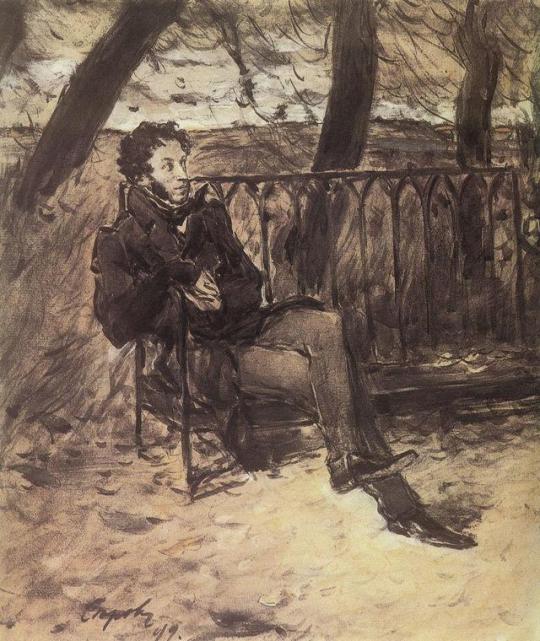
Valentin Serov. Alexander Pushkin In A Park.
1899. The Pushkin State Museum of Fine Arts, Moscow.
#Valentin Serov#Alexander Pushkin In A Park#XIX century#The Pushkin State Museum of Fine Arts#Moscow#Russia#art#realism#portrait#Pushkin#poet#literature#Валентин Серов#Александр Пушкин в парке#XIX век#Государственный музей изобразительных искусств имени Пушкина#Москва#Россия#искусство#реализм#Пушкин#поэт#литература
32 notes
·
View notes
Photo

Vasily Polenov. Chapel on the banks of the Oka.
1893. State Museum Preserve "Rostov Kremlin", Rostov.
#Vasily Polenov#Chapel on the banks of the Oka#XIX century#State Museum Preserve Rostov Kremlin#Rostov#Russia#art#realism#church#nature#river#forest#spiritual#Василий Поленов#Часовня на берегу Оки#XIX век#искусство#реализм#лес#Ока#Ростов#Россия#природа#церковь#Государственный музей-заповедник Ростовский Кремль
20 notes
·
View notes
Photo

Mikhail Vrubel. Salieri Pours Poison Into A Mozart's Glass.
1884. State Russian Museum, Saint Petersburg.
Antonio Salieri (1750 – 1825) was a central figure in the musical world of late eighteenth-century Vienna. Appointed by the Habsburg court as director of the Italian opera, he also served as the Austrian imperial Kapellmeister from 1788 to 1824.
Salieri’s place in popular imagination as Mozart’s nemesis and even alleged murderer goes at least as far back as 1832, when Alexander Pushkin published his short poetic drama “Mozart and Salieri”. There, Pushkin has Salieri murdering Mozart by pouring poison in his drink, after acknowledging the latter’s undisputed musical genius. As Salieri exclaims in Pushkin’s play:
What profundity!
What symmetry and what audacity!
You, Mozart, are a god — and you don't know it.
But I, I know.
However there is very little historical evidence found so far suggesting this theory is true. Moreover, rumour that Mozart had been poisoned by Salieri started to spread decades after Mozart’s death, further enhancing the theories behind Salieri’s alleged wicked character and malicious motives.
#Mikhail Vrubel#Salieri Pours Poison Into A Mozart's Glass#Mozart#Salieri#envy#jealousy#realism#murder#1791#State Russian Museum#Saint Petersburg#art#Russia#Михаил Врубель#Сальери всыпает яд в бокал Моцарта#XIX century#искусство#Государственный русский музей#Санкт-Петербург#Россия#реализм#зависть#убийство#Моцарт
24 notes
·
View notes